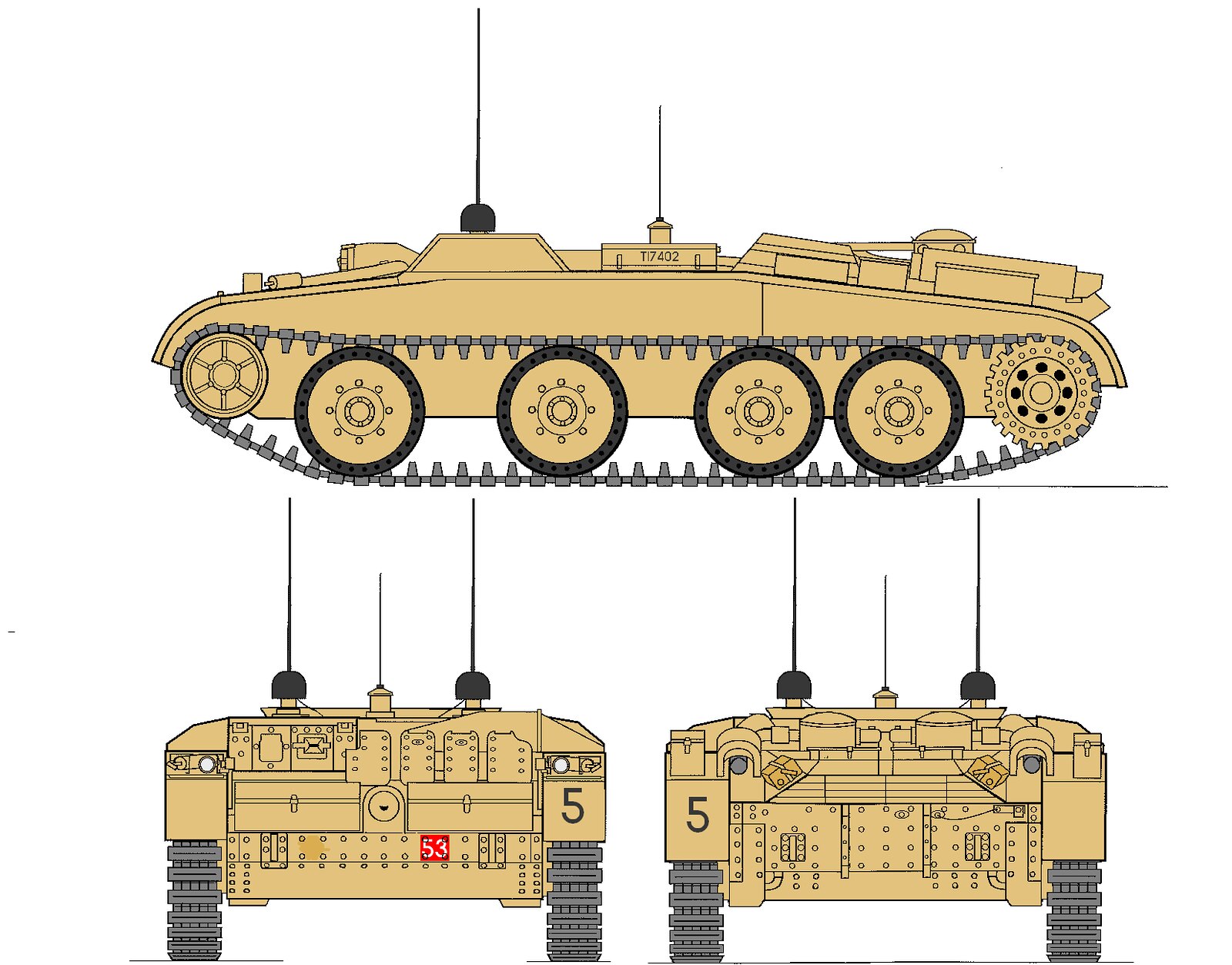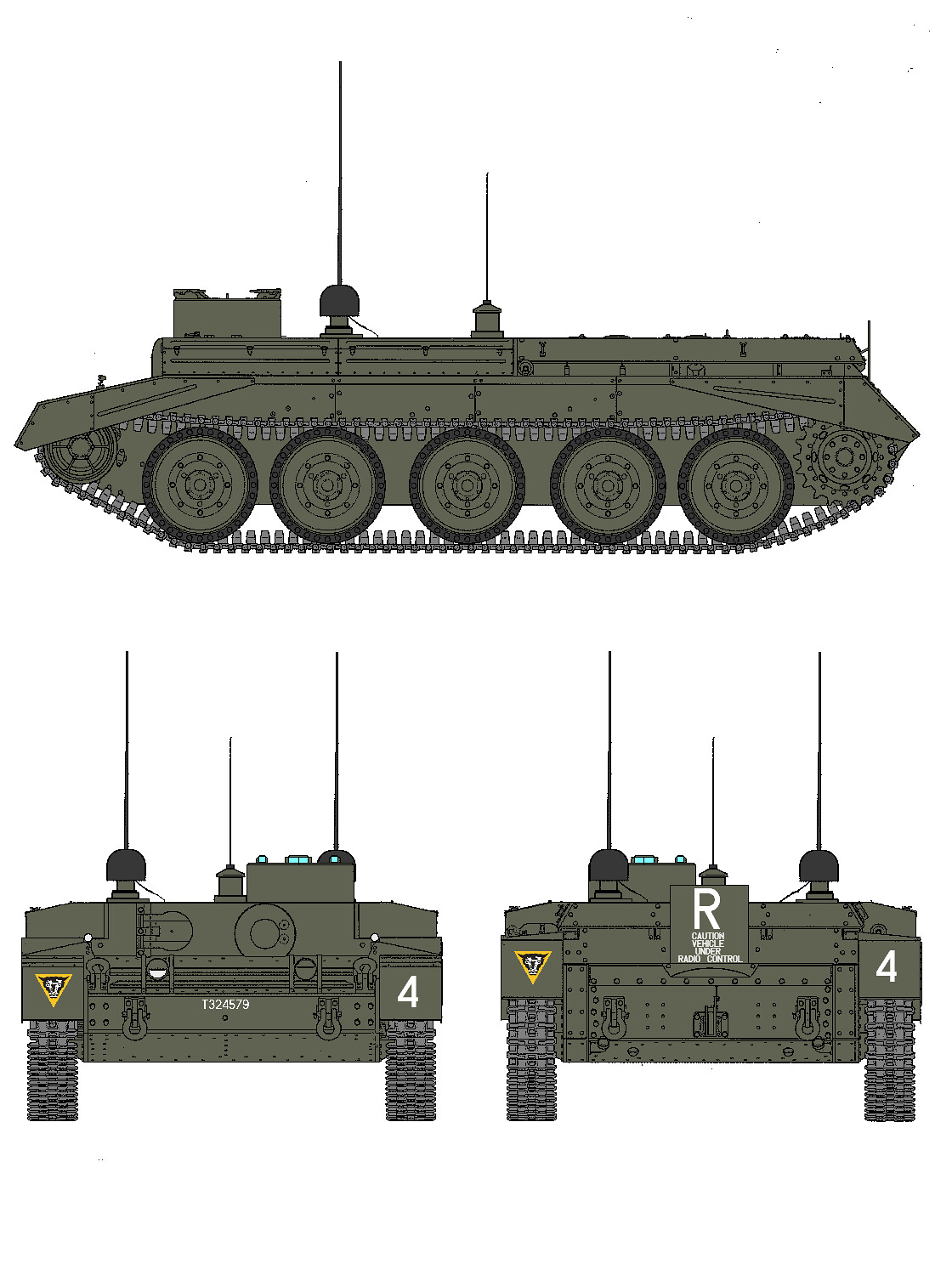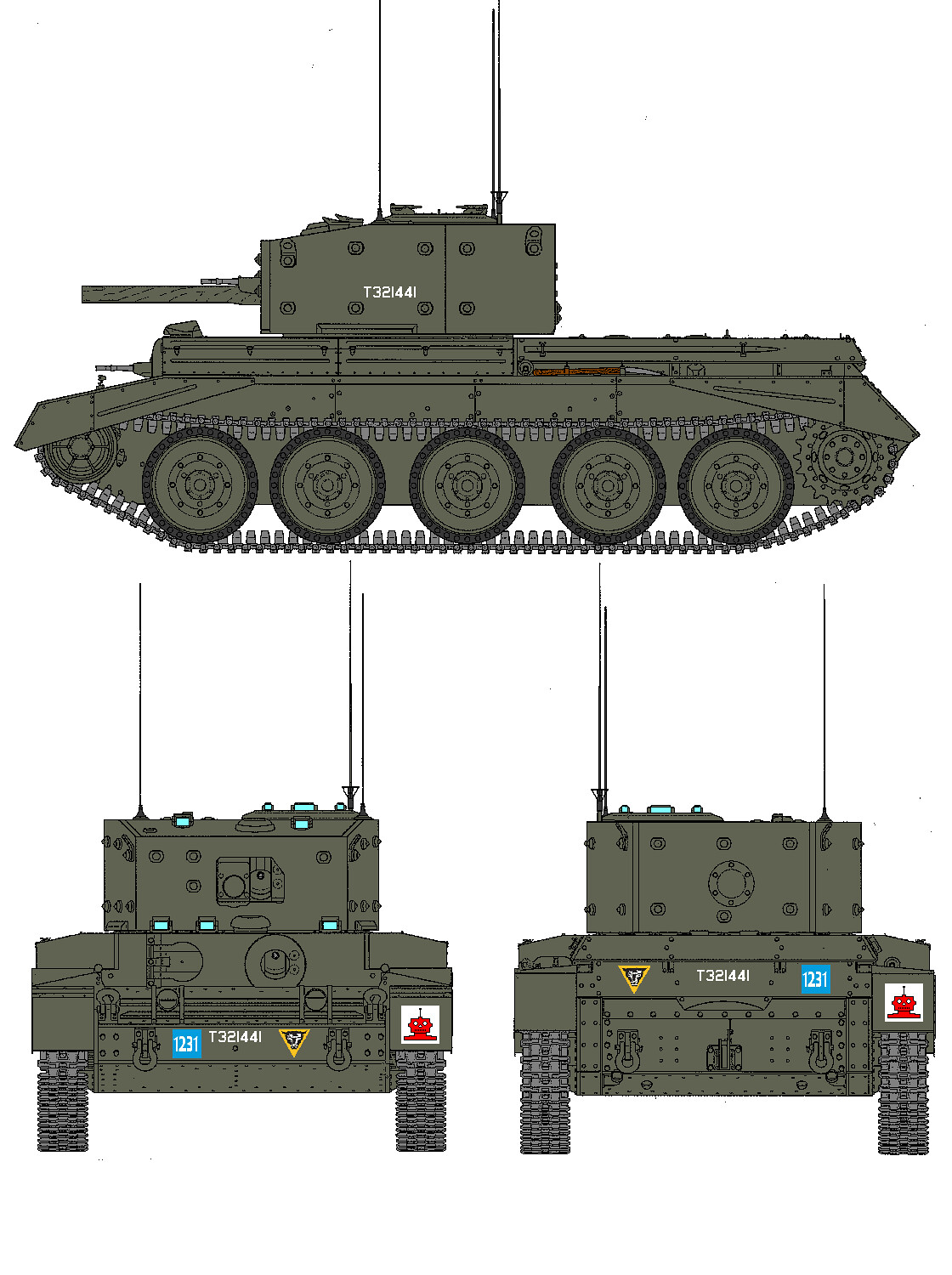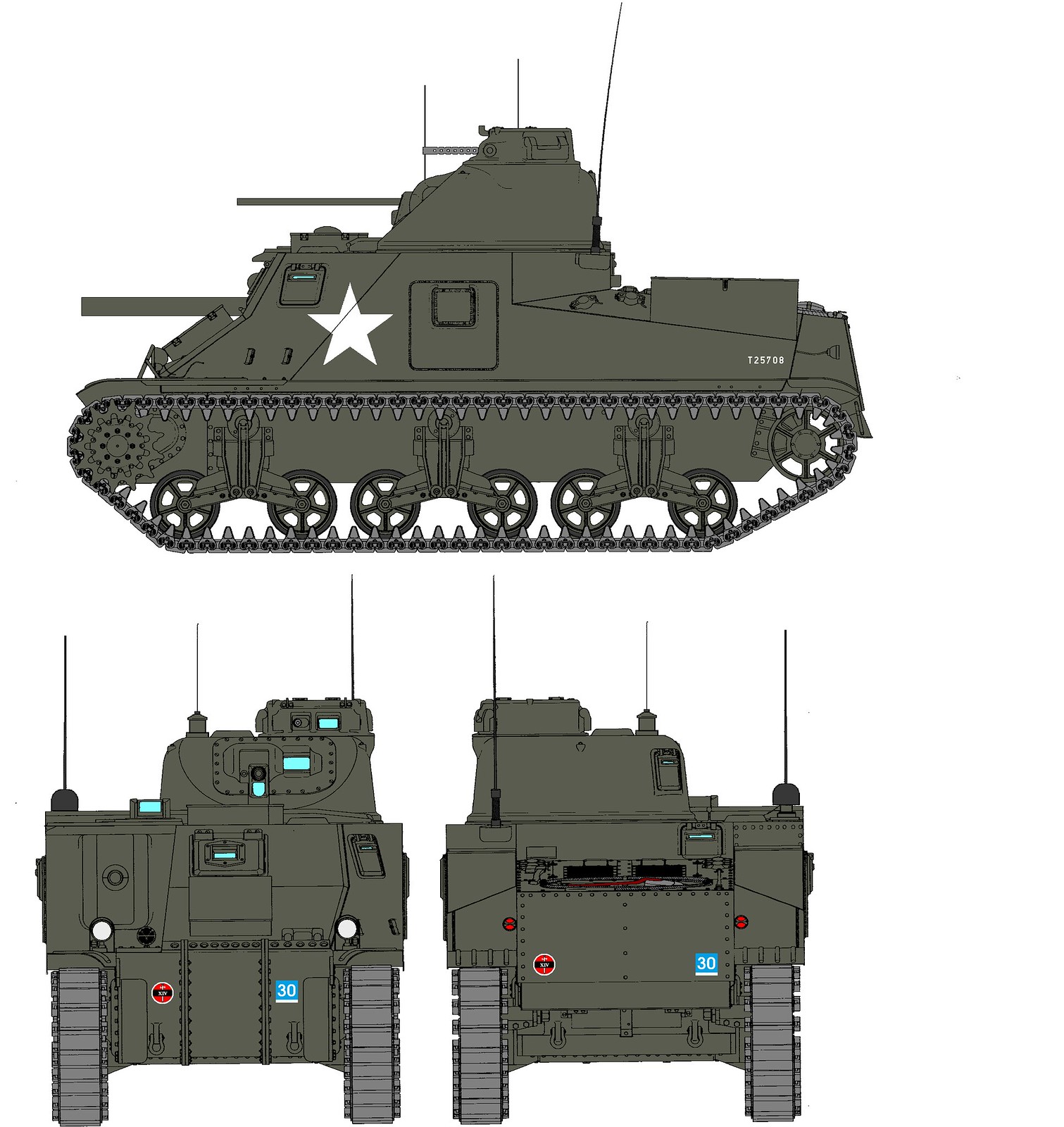Here's my efforts for this GB.
I'm quite sure that none of the engineering for this is actually doable, but it's a WHIF after all!
Cheers
Mark
The Armoured Breaching Unit – A brief history
North AfricaMounting losses of British tanks in North Africa forced a rethink of tactics and a general request for new ideas was also raised. The new German 75 and 88mm anti-tank guns were making mincemeat of British tanks, so solutions were needed.
Captain Ernest Jones of 1st Light Anti-Aircraft Regiment, Royal Artillery, offered a suggestion to help breech the German defensive lines. A pre-war TA member, Jones had taken part in gunnery exercises against radio-controlled Queen Bee target aircraft. He suggested that the same technology could be used to guide an unmanned tank to its target, where a demolition charge mounted inside, could be detonated by remote control.
His idea found favour with his divisional commander, Charles Willoughby Norrie, who forwarded it to Claude Auchinleck. With high command approval, Jones was ordered to set up a trial unit, pulling in personnel from a number of units within XXX Corps, to give him men skilled in the use of radio equipment, explosives and mechanics. Initial trials were made using redundant Bren Gun carriers, which were fitted with radio control equipment that allowed them to be driven remotely, from distances of up to 1 ½ miles.
With the initial technology in place, explosive trials followed, which through trial and error were eventually successful.
A combat test was to follow, with the experimental unit joining the front lines in early 1942. To support an attack on an Italian position, the unit deployed 4 converted Bren carriers. One was destroyed en route to the target, one lost radio connection, but two vehicles managed to reach the Italian front line, where they were detonated successfully.
Now dubbed the Armoured Breaching Unit, Jones was promoted to Major and given permission to expand the unit, giving it the capability to strike at German defensive lines, particularly against the dreaded 88s.
Bigger vehicles were needed, and after some evaluation, the redundant Covenanter tank was selected. It was big enough to carry a large detonation charge, fast enough to cover the ground quickly, and disposable enough that no one would mind if the vehicles were all destroyed. Conversions were undertaken, with the turrets being removed, to help make the vehicles faster. Light armoured plating was fitted over the turret collar, while the radio control equipment was also fitted. The converted vehicles were referred to as robots, a name that would stick. To control the robots, Major Jones was able to get hold of two AEC Dorchester armoured command vehicles, which were converted to mobile radio control stations, allowing for better control of the robot tanks, as they could be used closer to the front line because of the protect afforded by the armour.
The unit went into action at El Alamein, supporting XXX Corps, its Covenanter robots being used to attack German positions alongside the tanks of 9th Armoured Brigade. The attack across defended ground and minefields meant many of the robots were destroyed before reaching their targets, but those that did had a massive impact. Detonations destroyed numerous anti-tank gun positions, allowing the tanks of Royal Wiltshire Yeomanry to punch a hole through the German front line, followed by infantry from 2nd NZ Division and additional armoured units.
The robots were employed numerous times during the Allied advance across North Africa, until the Axis surrender in May 1943.
After the completion of the North African campaign, the ABU was ordered to the UK, taking with it its core experts as well as a selection of handbuilt specialist vehicles. This included 4 armoured command vehicles that the unit had built using surplus Deacon SPGs.


 North West Europe
North West EuropeIn the UK the unit was expanded, while standard robots were initially designed using redundant Crusader tanks as their basis. These preparations were part of the build up of forces prior to D-Day, with the ABU coming under the overall command of 79th Armoured Division, whose “Funnies” would be vital to operations during and after the invasion. In the build up to D Day, the Army Board opted to allow the ABU to use Cavalier tanks for its robots, as the entire production run was considered to be surplus to requirements. The converted Cavaliers began to reach the ABU in mid 1944 and would be the main weapon used by the unit up to the end of WW2. To support the unit in action a number of Cavalier OP tanks were issued, being used as relay stations between the robots and the armoured command vehicles.
Arriving in France on 18th June 1944, the ABU was soon in action, with its robots being used in support of operations to liberate Caen.
Following the breakout from Normandy, the ABU was in action during every British advance, which saw some changes to the equipment.
As a result of operational experience the Cavalier robots were fitted with an armoured cupola to house its control equipment, mounted on the plated in turret ring. Additionally, the tanks were fitted with a notice board on the rear, marked with a large letter R and a notice that the vehicle was under radio control, so that other troops in the vicinity would be able to pick out the robots from other armoured vehicles.
As the Allies advanced across Belgium, The Netherlands and Germany, the robots were in constant demand, especially when fighting was in urban environments, where ambush by AT guns and panzerfausts were frequent. The robots proved excellent at clearing roadblocks and dislodging dug in German emplacements.
With the end of the war, the unit was put into “suspended animation”, with Lieutenant Colonel Jones being awarded the DSO for his part in building and sustaining the unit, and his front line role, which often saw him in the thick of the action as the robots went into action. The remaining robots were mothballed, pending any future conflict.


 The Burma Campaign
The Burma CampaignIndia command was informed of the success of the ABU in mid 1944 and saw an opportunity to create a similar, if smaller, unit for similar operations against dug in Japanese positions. The IJA proved to be the masters of bunker warfare, so an autonomous weapon that could demolish these was seen as a boon.
The Armoured Breeching Unit (India) (ABU (I)) was formed in September 1944, and would eventually see action at Meiktila and Mandalay, using its equipment to help overcome some tough Japanese defensive positions. The ABU(I) used converted Australian pattern carriers, which were available in India in some numbers. The LP carriers were used in the robot role in preference to old tanks, as India command did not have the large surplus of tanks available in North Africa and Europe. Command vehicles were hard to come by, but the unit was able to scratch up a small number of battle damaged Lee’s, which were fitted with dummy guns and radio control equipment, allowing the unit to deploy its robots and control them close to the battle lines.
After the fall of Mandalay, the ABU(I) was involved in the race to Rangoon, deploying its dwindling number of robots to destroy the toughest of Japanese bunker positions along the way.
Like its “parent” unit the ABU(I) was disbanded after the Japanese surrender.


 Post script – The 1950s
Post script – The 1950sWith the outbreak of the Korean War, a number of Cavalier robots were drawn from storage, with the intention that they might be sent to the battle zone. However by the time the vehicles were ready and enough men trained to use them, the battle lines had become static and the need for breeching equipment was no longer thought necessary. The vehicles were returned to storage and the troops returned to their original units.
In 1956, in preparation for the landing at Suez, the army resurrected the idea of robot tanks, particularly for the highly dangerous role of clearing mines. Intelligence sources indicated that the Egyptians had laid heavy minefields between Port Said and the rest of the canal, which would seriously impinge the allies operations. To counter this, the army fitted the radio control equipment from the old Cavaliers to a small number of Centaur dozers. To clear the mines, the dozers were converted to carry the mine flail equipment, formerly used by Sherman Crabs. Two Centaur robots landed with the British armoured units, and were used to clear a path for the advance of the Centurions, without the need to endanger a crew’s life. One Centaur broke down after clearing a path, while the other was later driven by a real crew in support of the Centurions, in case it was needed again. At Suez the robots were controlled from a standard Bedford QLR truck, as “serious opposition” was not expected, plus the army did not have enough time to convert an armoured vehicle to the role.
With the British withdrawal from Suez, the Centaurs were sent back to storage and finally scrapped and the army finally laid to rest its robot tanks.

